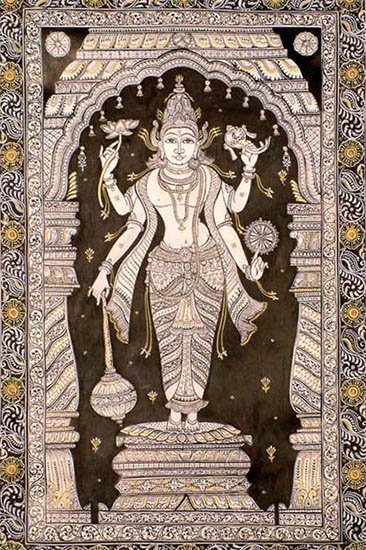Ardhacitra, Ardha-citra: 3 definitions
Introduction:
Ardhacitra means something in Hinduism, Sanskrit. If you want to know the exact meaning, history, etymology or English translation of this term then check out the descriptions on this page. Add your comment or reference to a book if you want to contribute to this summary article.
Alternative spellings of this word include Ardhachitra.
In Hinduism
Shilpashastra (iconography)
Source: Shodhganga: The significance of the mūla-beras (śilpa)Ardhacitra (अर्धचित्र) or Citrārdha refers to a “high relief sculpture” and represents a classification of Hindu images, as defined in the texts dealing with śilpa (arts and crafs), known as śilpaśāstras.—There is another classification of images into three kinds—chitra (depiction of a painting-two dimensional), chitrārdha/ardha-chitra (high relief sculpture) and chitrabhāsa (relief sculpture). Chitrārdha is an image in which half the body is not seen. It is to be done with mineral colours. It is known bhittyādaulagna-bhāvenāpy-ardhaṃ (when half of its being is attached to a wall or the surface).
Source: Shodhganga: Vaisnava Agamas And Visnu ImagesArdhacitra (अर्धचित्र) refers to “relief metal icons”, as defined in treatises such as the Pāñcarātra, Pādmasaṃhitā and Vaikhānasa-āgamas, extensively dealing with the technical features of temple art, iconography and architecture in Vaishnavism.—The Vaiṣṇava Āgamas insist that the metal icons should be made through a casting process called Madhūcchiṣṭa-kriyā. Re-iteration of this process in every place in the Agamic texts dealing with metal icons shows that there are other possible processes for metal casting. Prohibition of relief metal icons (ardhacitra) is an important aspect in the Vaiṣṇava Āgamas. Probably the casting of relief icons is by the moulding way (plate moulding). Hollow icons (antaḥsuṣira) are generally created by attaching two relief icons of one-side moulding. This is al o prohibited in the Vaiṣṇava Āgamas.

Shilpashastra (शिल्पशास्त्र, śilpaśāstra) represents the ancient Indian science (shastra) of creative arts (shilpa) such as sculpture, iconography and painting. Closely related to Vastushastra (architecture), they often share the same literature.
Languages of India and abroad
Sanskrit dictionary
Source: DDSA: The practical Sanskrit-English dictionaryArdhacitra (अर्धचित्र).—a. Half-transparent; A kind of marble; अर्धाङ्गदृश्यमानं च तदर्धचित्रमिति स्मृतम् (ardhāṅgadṛśyamānaṃ ca tadardhacitramiti smṛtam) Māna.51.1.
Ardhacitra is a Sanskrit compound consisting of the terms ardha and citra (चित्र).
Sanskrit, also spelled संस्कृतम् (saṃskṛtam), is an ancient language of India commonly seen as the grandmother of the Indo-European language family (even English!). Closely allied with Prakrit and Pali, Sanskrit is more exhaustive in both grammar and terms and has the most extensive collection of literature in the world, greatly surpassing its sister-languages Greek and Latin.
See also (Relevant definitions)
Partial matches: Ardha, Citra.
Full-text: Citrardha, Antahsushira, Madhucchishta, Pratimalakshana.
Relevant text
Search found 1 books and stories containing Ardhacitra, Ardha-citra; (plurals include: Ardhacitras, citras). You can also click to the full overview containing English textual excerpts. Below are direct links for the most relevant articles: